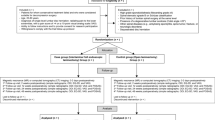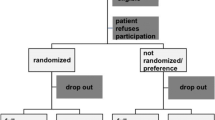Abstract
Background
There is a long-held concept among spine surgeons that endoscopic lumbar discectomy procedures are reserved for small-contained disc herniation; 8-year follow-up has not been reported. The purpose of this study is to assess microendoscopic discectomy (MED) in patients with large uncontained lumbar disc herniation (the antero-posterior diameter of the extruded fragment is 6–12 mm or more on axial cuts of MRI) and report long-term outcome.
Methods
One hundred eighty-five patients with MED or standard open discectomy underwent follow-up for 8 years. Primary (clinical) outcomes data included Numerical Rating Scale (NRS) for back and leg symptoms and Oswestry Disability Index (ODI) to quantify pain and disability, respectively. Secondary (objective) outcomes data included operative time, blood loss, postoperative analgesics, length of hospital stay, time to return to work, reoperation and complication rate, patient satisfaction index (PSI), and modified (MacNab) criteria.
Results
At the end of the follow-up, the leg pain relief was statistically significant for both groups. NRS back pain, ODI, PSI and MacNab criteria showed significant deterioration for control group. Secondary outcomes data of MED group were significantly better than the control group.
Conclusions
Large, uncontained, lumbar disc herniations can be sufficiently removed using MED which is an effective alternative to open discectomy procedures with remarkable long-term outcome. Although the neurological outcome of the two procedures is the same, the morbidity of MED is significantly less than open discectomy. Maximum benefit can be gained if we adhere to strict selection criteria. The optimum indication is single- or multi-level radiculopathy secondary to a single-level, large, uncontained, lumbar disc herniation.


Similar content being viewed by others
References
Dandy WE (1929) Loose cartilage from intervertebral disk simulating tumor of the spinal cord. Arch Surg 19:660–672 (Reference unverified)
Mixter WJ, Barr JS (2001) Rupture of intervertebral disc with involvement of the spinal canal. N Engl J Med 211:210–215
Deyo RA, Weinstein JN (2001) Primary care: low back pain. N Engl J Med 344:363–370
Williams DK, Park LA (2007) Lower back pain and disorders of intervertebral disc. In: Terry Canale S, Beaty HJ (eds) Campbell’s operative orthopaedics, 11th edn. Mosby-Year Book Inc., pp 2210–2212
Kim SM, Park K-W, Hwang C et al (2009) Recurrence rate of lumbar disc herniation after open discectomy in active young men. Spine 34(1):24–29
Skaf G, Bouclaous C, Alaraj A, Chamoun R (2005) Clinical outcome of surgical treatment of failed back surgery syndrome. Surg Neurol 64(6):483–488
Abumi K, Panjabi MM, Kramer KM et al (1990) Biomechanical evaluation of lumbar spinal stability after graded facetectomies. Spine 15:1142–1147
Kotilainen E, Valtonen S (1993) Clinical instability of the lumbar spine after microdiscectomy. Acta Neurochir 125:120–126
Haher TR, O’Brien M, Dryer JW et al (1994) The role of the lumbar facet joints in spinal stability. Identification of alternative paths of loading. Spine 19:2667–2670
Hopp E, Tsou PM (1988) Postdecompression lumbar instability. Clin Orthop 227:143–151
Kaigle AM, Holm SH, Hansson TH (1995) Experimental instability in the lumbar spine. Spine 20:421–430
Kato Y, Panjabi MM, Nibu K (1998) Biomechanical study of lumbar spinal stability after osteoplastic laminectomy. J Spinal Disord 11:146–150
Kotilainen E (2001) Clinical instability of the lumbar spine after microdiscectomy. In: Gerber BE, Knight M, Siebert WE (eds) Lasers in the musculoskeletal system. Springer, Berlin, pp 241–243
Sharma M, Langrana NA, Rodrigues J (1995) Role of ligaments and facets in lumbar spinal stability. Spine 20:887–900
Lewis PJ, Weir BKA, Broad RW et al (1987) Longterm prospective study of lumbosacral discectomy. J Neurosurg 67:49–54
Cooper R, Mitchell W, Illimgworth K et al (1991) The role of epidural fibrosis and defective fibrinolysis in the persistence of postlaminectomy back pain. Spine 16:1044–1048
Waddell G, Reilly S, Torsney B et al (1988) Assessment of the outcome of low back surgery. J Bone Jt Surg Br 70:723–727
Ozgen S, Naderi S, Ozgen MM et al (1999) Findings and outcome of revisionlumbar disc surgery. J Spinal Disord 12:287–292
Vishteh AG, Dickman CA (2001) Anterior lumbar microdiscectomy and interbody fusion for the treatment of recurrent disc herniation. Neurosurgery 48:334–337
Salenius P, Laurent LE (1977) Results of operative treatment of lumbar disc herniation. A survey of 886 patients. Acta Orthop Scand 48:630–634
Weber H (1983) Lumbar disc herniation. A controlled, prospective study with ten years of observation. Spine 8:131–140
Hakelius A (1970) Prognosis in sciatica. A clinical follow-up of surgical and nonsurgical treatment. Acta Orthop Scand Suppl 129:1–76
Hanley EN Jr, Shapiro DE (1989) The development of low-back pain after excision of a lumbar disc. J Bone Joint Surg (Am) 71:719–721
Kim KD, Wang JC, Roderston DB, Brodke DS, Olson EM, Duberg AC, Bendebba M, Block KM, Dizerega GS (2003) Reduction of radiculopathy and pain with oxyplex/SP gel after laminectomy, laminotomy and discectomy: a pilot study. Spine 28:1080–1087
Hoyland JA, Freemnt AJ, Denton J, Thomas AMC, McMillan JJ, Jayson MIV (1988) Retained surgical swab in post-laminectomy arachnoiditis and peridural fibrosis. J Bone Jt Surg 70:659–662
Lee CK, Alexander H (1984) Prevention of postlaminectomy scar formation. Spine 9:707–713
Foley KT, Smith MM (1997) Microendoscopic discectomy. Tech Neurosurg 3:301–307
Smith MW, Foley KT (1998) Microendoscopic discectomy: the first 100 cases. Annual Meeting of the Congress of Neurological Surgeons, Seattle, Oct 1998
Perez-Cruet MJ, Smith M, Foley K (2002) Microendoscopic lumbar discectomy. In: Fessler RG, Perez-Cruet MJ (eds) Outpatient spinal surgery. Quality Medical, St. Louis, pp 171–183
Wu X, Zhuang S, Mao Z, Chen H (2006) Microendoscopic discectomy for lumbar disc herniation: surgical technique and outcome in 873 consecutive cases. Spine 31(23):2689–2694
Muramatsu K, Hachiya Y, Morita C (2001) Postoperative magnetic resonance imaging of lumbar disc herniation: comparison of microendoscopic discectomy and Love’s method. Spine 26:1599–1605
Schick U, Döhnert J, Richter A et al (2002) Microendoscopic lumbar discectomy versus open surgery: an intraoperative EMG study. Eur Spine J 11:20–26
World Medical Association (2002) Declaration of Helsinki (Accessed 30 April 2002, at http://www.wma.net/e/policy/b3.htm)
Carragee EJ, Han M, Kim D, Yang B, Stanford CA (1999) Fragment-type and annular defect as predictive factors in lumbar discectomy. In: Presented at the 14th annual meeting of North American Spine Society (NASS), Chicago Hilton and Towers, Oct 1999
Derby R, Howard MW, Grant GM et al (1999) The ability of pressure controlled discography to predict surgical and nonsurgical outcomes. Spine 24(4):364–372
Fairbank J, Pynsent P (2000) The Oswestry Disability Index. Spine 25:2940–2953
Daltroy LH, Cats-Baril WL, Katz JN et al (1996) The North American Spine Society (NASS) lumbar spine outcome instrument: reliability and validity tests. Spine 21:741–749
MacNab I (1971) Negative disc exploration. J Bone Jt Surg Am 53:891–903
Landis JR, Koch GG (1977) The measurement of observer agreement for categorical data. Biometrics 33:159–174
Shrout PE, Fleiss JL (1979) Intraclass correlations: uses in assessing rater reliability. Psychol Bull 86:420–428
Palmer S (2002) Use of tubular retractor system in microscopic lumbar discectomy: one year prospective results in 135 patients. Neurosurg Focus 13(2):E5
Schizas C, Tsiridis E, Saksena J (2005) Microendoscopic discectomy compared with standard microsurgical discectomy for treatment for uncontained or large contained disc herniations. Neurosurgery 57(suppl. 3):357–360
Dvorak J, Gauchat M-H, Valach L (1988) The outcome of surgery for lumbar disc herniation. 1. A 4–17 years’ follow-up with emphasis on somatic aspects. Spine 13:1418–1422
Brayda-Bruno M, Cinnella P (2000) Posterior endoscopic discectomy (and other procedures). Eur Spine J 9(Suppl. 1):24–29
Ruetten S, Komp M, Merk H, Godolias G (2008) Full-endoscopic interlaminar and transforaminal lumbar discectomy versus conventional microsurgical technique: a prospective, randomized, controlled study. Spine 33(9):931–939
Tosteson NAA, Tosteson DT, Lurie DJ et al (2011) Comparative effectiveness evidence from the spine patient outcomes research trial surgical versus nonoperative care for spinal stenosis, degenerative spondylolisthesis, and intervertebral disc herniation. Spine 36(24):2061–2068
Acknowledgments
The authors acknowledge the assistance of Dr. Safaa El-Najjar for providing statistical analysis and also acknowledge the rest of the Zagazig Orthopedic Department’s members (medical and non-medical) for their contributions to the present study.
Conflict of interest
The authors did not receive any outside funding or grants in support of their research for or preparation of this work. Neither they nor a member of their immediate families received payments or other benefits or a commitment or agreement to provide such benefits from a commercial entity. No commercial entity paid or directed, or agreed to pay or direct, any benefits to any research fund, foundation, division, center, clinical practice, or other charitable or nonprofit organization with which the authors, or a member of their immediate families, are affiliated or associated.
Author information
Authors and Affiliations
Corresponding author
Rights and permissions
About this article
Cite this article
Hussein, M., Abdeldayem, A. & Mattar, M.M.M. Surgical technique and effectiveness of microendoscopic discectomy for large uncontained lumbar disc herniations: a prospective, randomized, controlled study with 8 years of follow-up. Eur Spine J 23, 1992–1999 (2014). https://doi.org/10.1007/s00586-014-3296-9
Received:
Revised:
Accepted:
Published:
Issue Date:
DOI: https://doi.org/10.1007/s00586-014-3296-9




